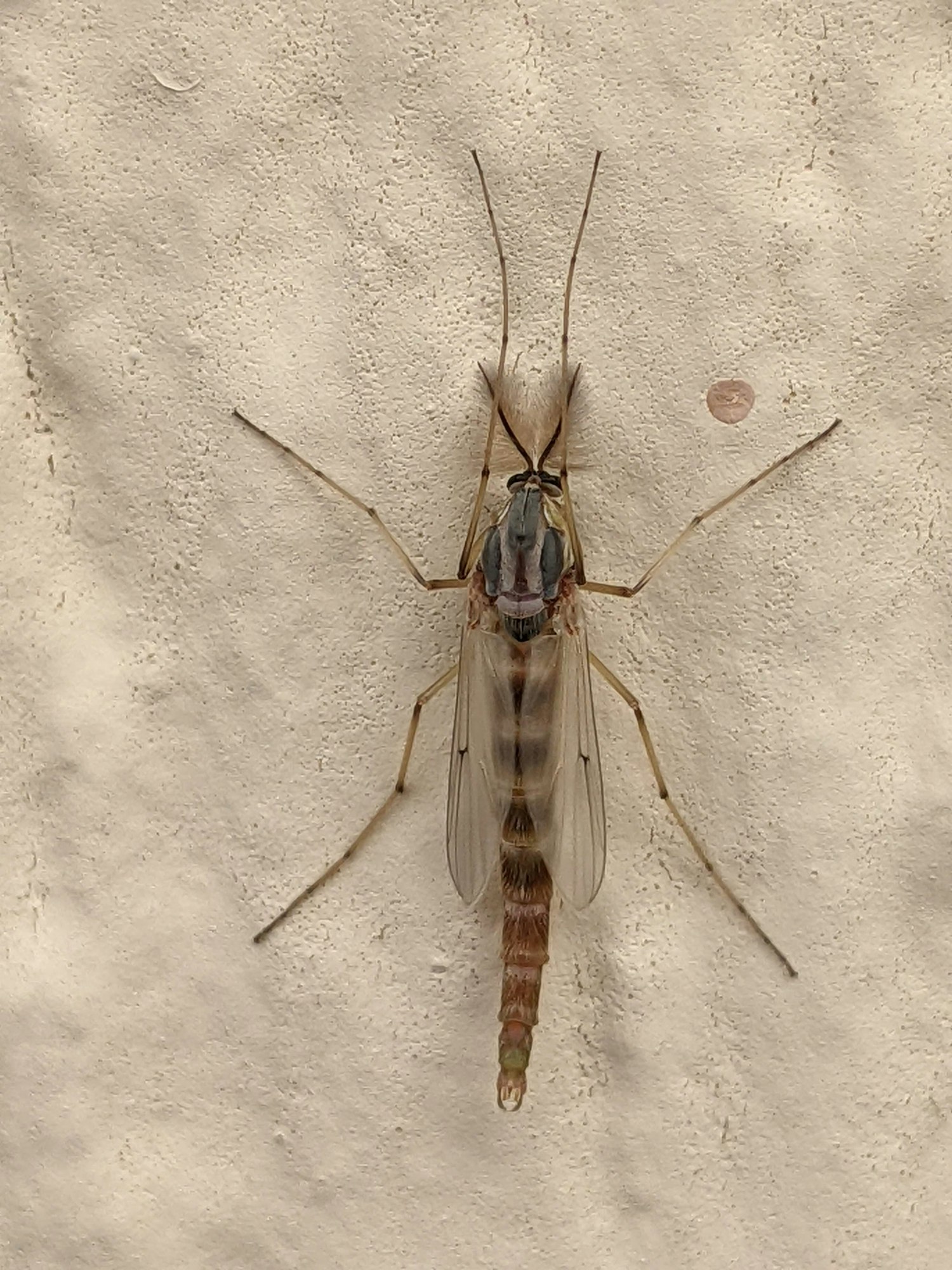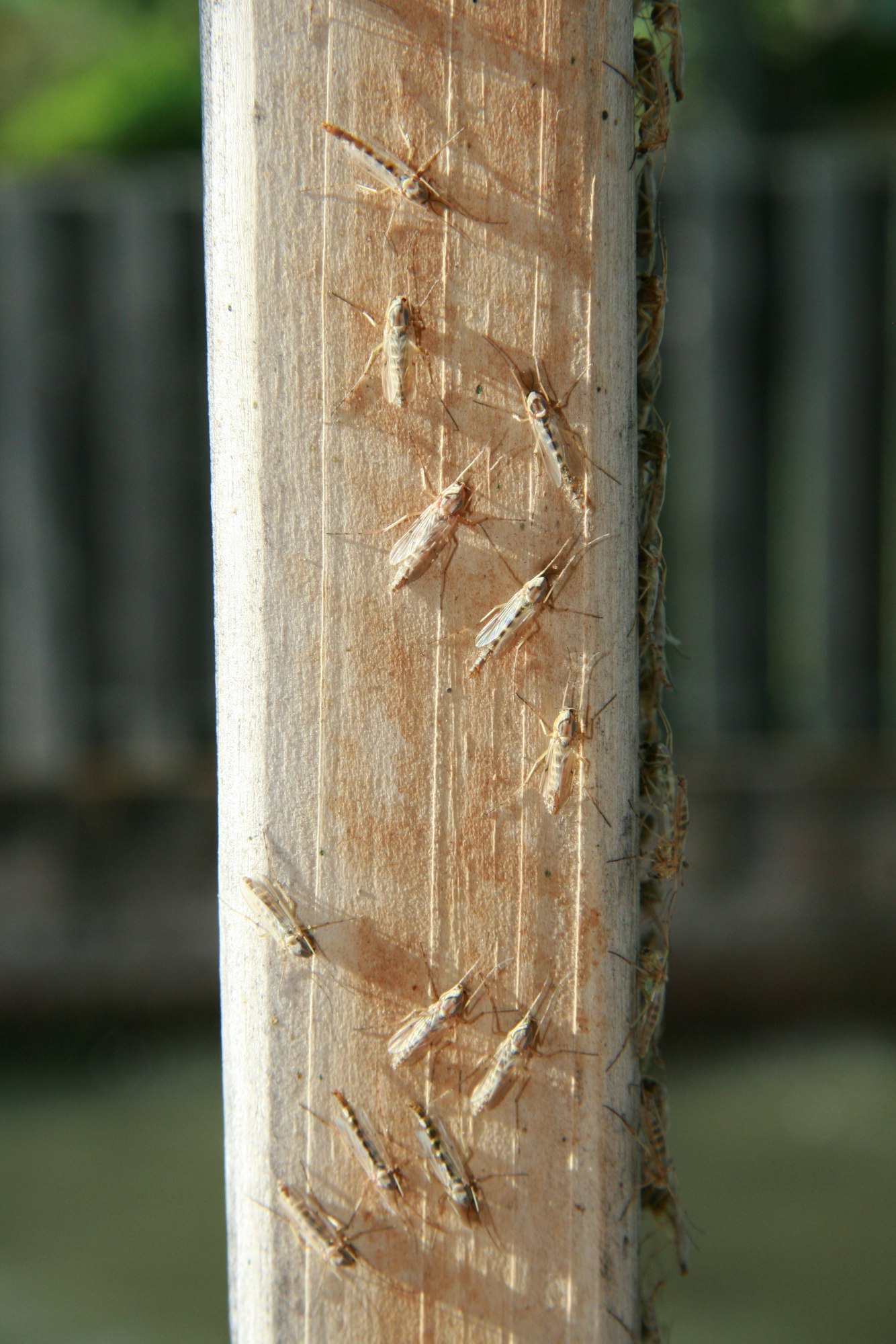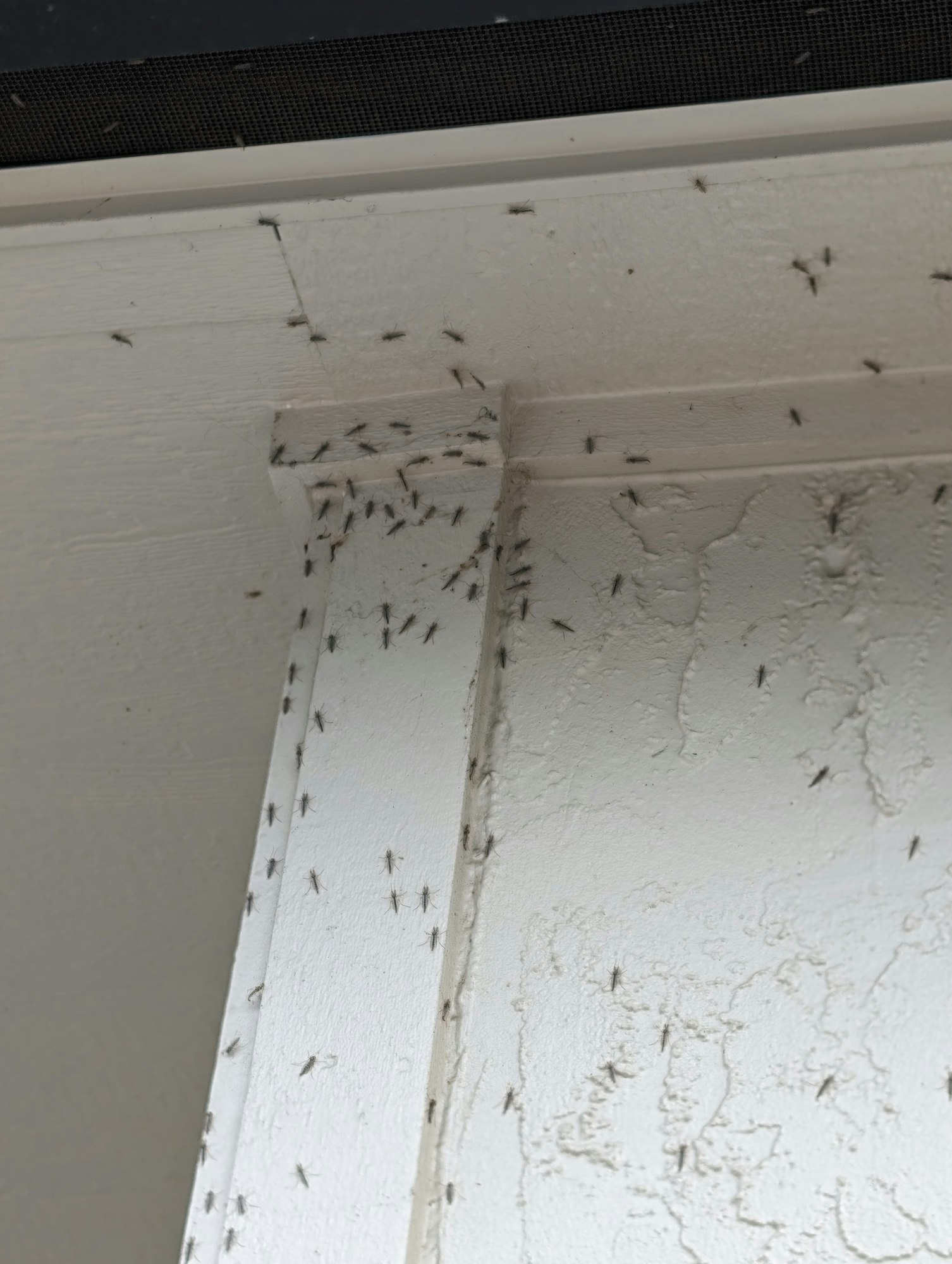Is that a Midge or a Mosquito?
Midges, aka "gnats" or "rice flies", are common names that generally define any number of small, non-biting flies with two wings. Chironomid midges (non-biting flies in the family Chironomidae) are the most common midges encountered in Lake County. These pestiferous but harmless insects are often confused with mosquitoes. This is because midges look similar to mosquitoes and their immature stages share many of the same water sources. Like mosquitoes, midges can survive in polluted, stagnant water. Here in Lake County our primary source for midges is Clear Lake. In fact, the Clear Lake Gnat (Chaoborus astictopus) or Phantom Midge, is native to Clear Lake and was a major pest concern due to its sheer abundance in the 1940s-1970s.
Commonly Encountered Midges
- "Rice Flies": There are several species, but the most common is Chironomus plumosus: Averaging ½", it is the largest midge in North America and is common around Clear Lake in the spring and summer. Larvae, commonly called "Bloodworms", are usually reddish in color as a result of hemoglobin in the lymph system. Larvae live in the mud, so they filter feed on organic debris on the lake bottom. They also build "horseshoe" shaped tubes around their bodies and circulate water through these tubes. Adults emerge in large plumes and can form mating swarms in the evening that can be readily seen by residents living near the lake. Individual adults live less than 48 hrs. Still not sure if it's a rice fly or a mosquito? Here's a side-by-side comparison of rice flies and mosquitoes.


.jpg?ixlib=rb-1.1.0&w=2000&h=2000&fit=max&or=0&s=6128d414aeece3a5d81d0663b01a1cf0)





.jpg?ixlib=rb-1.1.0&w=2000&h=2000&fit=max&or=0&s=6128d414aeece3a5d81d0663b01a1cf0)



- Chironomid midges: This diverse group includes the "rice flies" and their many smaller relatives. Most chironomid midges are less than 1/4" (6.5 mm) long and may be bright green, black, yellow, white, orange, or tan. Like the rice flies, other chironomid midges cannot bite, live less than 48 hours as adults, are attracted to light, and form large conspicuous swarms.
.jpg?ixlib=rb-1.1.0&w=2000&h=2000&fit=max&or=90&s=257013bf6e6daa05a6fde600cec2d5f6)
- Clear Lake Gnats: Clear Lake gnat (Chaoborus astictopus) adults have reduced mouthparts and are cannot bite. They are much smaller than mosquitoes and other midges of Clear Lake and can pass through large window screens. These gnats are also called "Phantom Midges", because the larvae are transparent making them very difficult to see. There are 4 larval stages (instars) and 4th instar larvae migrate up and down in the water column. During the day they stay in the sediment and at night they move to the surface. Historically, they emerged in large numbers off of Clear Lake, creating a nuisance for local residents.
Another mosquito look-alike
Crane Flies (aka "mosquito hawks" or "mosquito eaters"): These delicate flies with stilt-like legs are commonly seen in and around homes. They vary in size, but can be as large as 1.5 inches (38 mm) in length. They are often confused with mosquitoes or as "mosquito eaters", however they do not bite people and do not eat mosquitoes. In fact, many adults have short life spans and do not eat at all. Crane fly larvae are commonly found in loose soil or organic matter, although some species can emerge from aquatic sources.
Is it a midge or a mosquito?
Midges, raise their forelegs at rest, while mosquito adults do not.
The wings of midges are shorter than their body, while mosquito wings are slightly longer than their body.
Midges have nonfunctional (reduced) mouth parts, while mosquitoes have a long proboscis (needle-like projection).
Midges form large mating swarms in the evening, which may occur over serveral days. While male mosquitoes may swarm when mating, they are typcially in a defined location and difficult to see.
Midges only live long enough to mate and lay their eggs, while certain species of mosquitoes can live for months at a time.
Midge Prevention
Midges are highly attracted to light, so minimizing the use of outside lights will help to reduce their presence near your home. Should you choose to use a "Bug Zapper", keep it as far away from your residence as possible to maximize its effectiveness. Keep doors and windows closed or tightly screened to prevent midges from entering your home. Using insecticides to control midges is NOT recommended because these midges are harmless and individuals have very short life spans so any nuisance they pose will be temporary and intermittent. Midges are important to the food chain as they provide food for fish and other aquatic animals.
Clear Lake Gnat Monitoring
As part of the Lake County Vector Control District's ongoing surveillance of the Clear Lake Gnat (Chaoborus astictopus) population, we have been monitoring various nuisance pests (midges), associated organisms (plankton), and inshore fish in Clear Lake since 1954. We sample the lake each month for benthic (lake bottom) organisms and plankton. In additon to these "lake checks", we also evaluate water quality parameters: temperature, pH, total hardness, disolved oxygen, and specific conductance. The District has also continued to conduct beach seines (inshore fish sampling) on Clear Lake.
Ekman Dredge
Monitoring is conducted on all three arms of the lake: Upper, Lower, and Oaks. Presently, we sample 14 stations in the Upper arm, 6 stations in the Oaks arm, and 9 stations in the Lower arm. Two 6-in cubed Ekman dredges are used to sample the lake bottom at each station. Samples are collected by lowering each Ekman dredge to the lake bottom. Dredges are spring loaded with a "messenger" that travels down the rope and triggers the jaws of the dredge to close. The dredges are hauled up and the "mud" samples from each dredge are sieved to remove the sediment, leaving the benthic organisms behind. The organisms collected at each station are identified and counted at our laboratory. We also record top and bottom water temperature and water depth at each station. Additional water quality parameters are only taken once in each arm of the lake.
What's identified in the benthic samples?
Chaoboridae: Clear Lake Gnat (Chaoborus astictopus) immatures; larvae are transparent and nearly invisible in the water; larvae feed on plankton and other small aquatic animals; adults are non-biting.
Chironomidae: Known as chironomids or non-biting midge immatures; these midges are ubiquitous in freshwater worldwide and are often bright red because of hemoglobin content; larvae live in the muddy bottom of Clear Lake (over 50 per square meter) and eat decaying matter; adults are non-biting. Two subfamilies are counted within this group: Chironominae and Tanypodinae.
Hirudinea: Leeches; these are small (1-3 cm) leeches with 2 suckers on each end on the bottom of the body; some feed on the blood of fish or turtles, but most are free-living predators; free-living leeches avoid light and generally hide in the detritus at the lake bottom; they feed mostly on insects, molluscs and oligochaetes, or are scavengers, feeding on dead animal matter.
Plankton Tows
Clear Lake plankton (phytoplankton and zooplankton) are collected via the Vertical Tow method. One sample per arm, per month is typically collected throughout the year. Vertical Tow samples are collected by lowering a conical vertical tow plankton net to the bottom of the water column and hauling it through a vertical path back to the surface. The net must be hauled slowly to minimize the possibility of positive water pressure developing at the mouth of the net. Positive water pressure will push water out of the path of the net and prevent capture of some of the sample. Because of the potential for this method to decrease plankton capture, vertical tow samples are best regarded as qualitative rather than quantitative. A maximum of 36 plankton samples are collected and analyzed annually through the District's monitoring of Clear Lake. The collected plankton are a minute representative sample of the total population. The absence of a species from these data should not be considered conclusive evidence of its absence from Clear Lake.
For information on algae in Clear Lake: Click HERE
